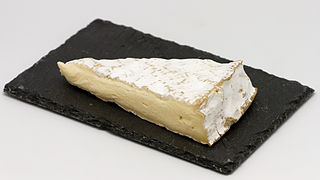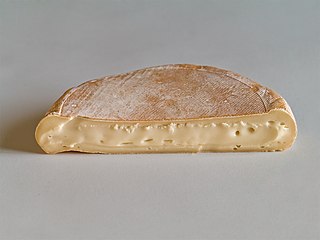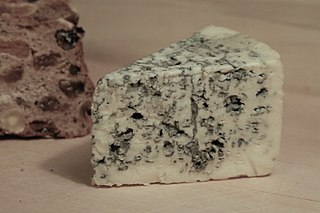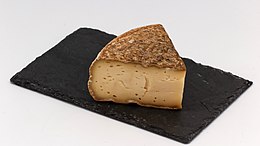
Brie is a soft cow's-milk cheese named after Brie, the French region from which it originated. It is pale in colour with a slight greyish tinge under a rind of white mould. The rind is typically eaten, with its flavour depending largely upon the ingredients used and its manufacturing environment. It is similar to Camembert, which is native to a different region of France. Brie typically contains between 60% and 75% butterfat, slightly higher than Camembert.

Tomme, occasionally spelled Tome, is a class of cheeses produced mainly in the French Alps and in Switzerland. It can be made from cow's, ewe's, or goat's milk. Tommes are normally produced from the skimmed milk left over after the cream has been removed to produce butter and richer cheeses, or when there is too little milk to produce a full cheese. As a result, they are generally low in fat. However, Tomme de Boudane and Tomme de Revard can contain as much as 20–40% fat. Tomme cheeses date back to ancient history.

Camembert is a moist, soft, creamy, surface-ripened cow's milk cheese. It was first made in the late 18th century in Camembert, Normandy, in northwest France. It is sometimes compared in look, taste and texture to brie cheese, albeit with a slightly lower butterfat content than brie's typical 20% – 25% by weight.

Reblochon is a soft washed-rind and smear-ripened French cheese made in the Alpine region of Haute-Savoie from raw cow's milk. It has its own AOC designation.

Munster, Munster-géromé, or (Alsatian) Minschterkaas, is a soft cheese with a strong taste and aroma, made mainly from milk first produced in the Vosges, between the Alsace-Lorraine and Franche-Comté regions in France. The name "Munster" is derived from the Alsace town of Munster, where, among Vosgian abbeys and monasteries, the cheese was conserved and matured in monks' cellars.

Comté is a French cheese made from unpasteurized cow's milk in the Franche-Comté region of eastern France bordering Switzerland and sharing much of its cuisine. Comté has the highest production of all French Appellation d'origine contrôlée (AOC) cheeses, at around 65,000 tonnes annually. It is classified as an Alpine cheese.

Beaufort is a firm, raw cow's milk cheese associated with the gruyère family. An Alpine cheese, it is produced in Beaufortain, Tarentaise valley and Maurienne, which are located in the Savoie region of the French Alps.

Saint-Nectaire is a French cheese made in the Auvergne region of central France.

Laguiole, sometimes called Tome de Laguiole, is a pressed uncooked French cheese from the plateau of Aubrac, situated at between 800 - 1400m, in the region of Aveyron in the southern part of France. It takes its name from the small town of Laguiole and has been protected under the French Appellation d'Origine Contrôlée (AOC) since 1961 and a Appellation d'origine protégée since 1996. Laguiole is said to have been invented at a monastery in the mountains of Aubrac in the 19th century. According to historical accounts, the monks passed down the recipe for making this cheese from cattle during the alpages to the local buronniers, the owners of burons, or mountain huts.

Ädelost is blue cheese from Sweden, made from pasteurized cow's milk. Swedish-made cheese, which is called "ädelost" or "ädel", is generally made from cow's milk and can be said to be a Swedish version of the French blue cheese.

Coulommiers is a soft ripened cheese from Coulommiers, Seine-et-Marne, France. It is made from cow's milk, and is usually in the shape of a disc with white, bloomy, edible Penicillium candidum rind. When produced as an artisanal or "farmhouse" cheese from unpasteurized milk, it has some reddish blush in parts of the rind. The period of ripening when made of pasteurised whole milk is about four to six weeks. The fat content is 40 per cent.

Tomme des Pyrénées is a mild French rustic cheese, sometimes prepared covered with a thin skin of black or brownish wax. In January, 2021, it was ascribed protected geographical indication certification and protection, which links the cheese to its specific geographic origin based upon factors such as quality, reputation or other characteristics.
Kunik is a brand of cow and goat milk cheese. It is described by the producer as a semi-aged, triple cream wheel cheese made from 25% Jersey cow cream and 75% goat's milk. It has an edible, bloomy white rind; a tangy, buttery flavor; and a thick, smooth, creamy texture. The addition of high-milkfat Jersey cow cream makes the cheese more rich and flavorful than a brie cheese, but less pungent than a pure goat cheese. Anne Saxelby, reviewing the cheese for Esquire, stated "it may very well be the sexiest cheese in the U.S.A."

Casín cheese is a Spanish cheese made in the Principality of Asturias. Its name is covered by a protected designation of origin (PDO). It is made from full-fat, unpasteurized cows' milk from specific breeds, namely Asturian Mountain, Asturian Valley (Asturiana de la Valles), Friesian and any crosses between these breeds. Specifically the geographic area of manufacture is the southern part of Asturias which includes the Redes Natural Park and associated land, this is within the municipalities of Caso, Sobrescobio and Piloña. The cheese is classified as hard and semi-hard, and can be semi-cured or cured. It takes its name from one of the breeds of cattle whose milk is used, in turn named after the town of Caso. The shape of the cheese is a thick disc-shape, sometime more conical, of 10–20 cm diameter and 4–7 cm in height. The weight is between 250 and 1,000 g.

Flor de Guía cheese is a Spanish cheese made on the island of Gran Canaria in the Canary Islands. It has Denomination of Origin protection. The cheese is classified as fatty or semi-fatty and made from the milk from Canarian sheep, with milk from Canarian cows and/or goats. The milk from the sheep must constitute at least 60% and cows’ milk content must never exceed 40%. Goat milk must never exceed 10% of the mixture. The cheese is presented in flat cylindrical cheeses which normally measure 4–8 cm high and 20–30 cm across and weighing between 2 and 5 kg. The cheese gets its name from an area in northern Gran Canaria called Santa María de Guía, where the cheese is made, and ‘flor’ from the fact that juice from the flowerheads of a species of cardoon and globe artichoke are used to curdle the milk.

Tome des Baugespronounced[tɔmdeboʒ] is a variety of Tomme cheese made in the Bauges mountains in the French Alps, in the Savoie department of the Auvergne-Rhône-Alpes region.















